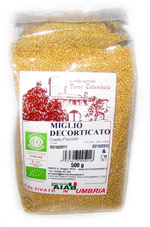OUR GROWING METHOD
It is a very ancient cereal, originally from the Middle East and some areas of Africa (where it still constitutes the main food along with rice).
As farro, it is a very rustic grain and it is resistant to adverse weather conditions.
It is sown in late spring, it is a very small plant, seemingly fragile, similar to lentils. It threshed in August, sometimes in September, too.
The seed is yellow, small (variety of central Italy, other than the largest, white, imported American grain), round, covered with a hull that looks like celluloid.
TRANSFORMATION
Being a covered cereal, it must be hulled at specific installations, before being eaten as hulled millet.
We also make flour out of it, which is ground at our mill stone. The resulting flour can be used for cakes (“pudding”), bread and even polenta: the latter was its major use in Northern Italy, before it was replaced by imported American corn.
BENEFITS
Compared to wheat, millet contains a greater degree of vitamin A, B vitamins, many minerals and some essential amino acids (it is also for this reason, and for the different and positive qualities of barley, khorasan wheat, barley, we have coined the claim, copied from apples, a corn a day keeps the doctor away).
The millet grain, such as rice, does not contain gluten and it is therefore suitable to the diet of those who are intolerant to that substance.
It has an alkalizing effect, therefore it fights acidity. It also has a refreshing and rejuvenating effect on skin, hair and nails.

